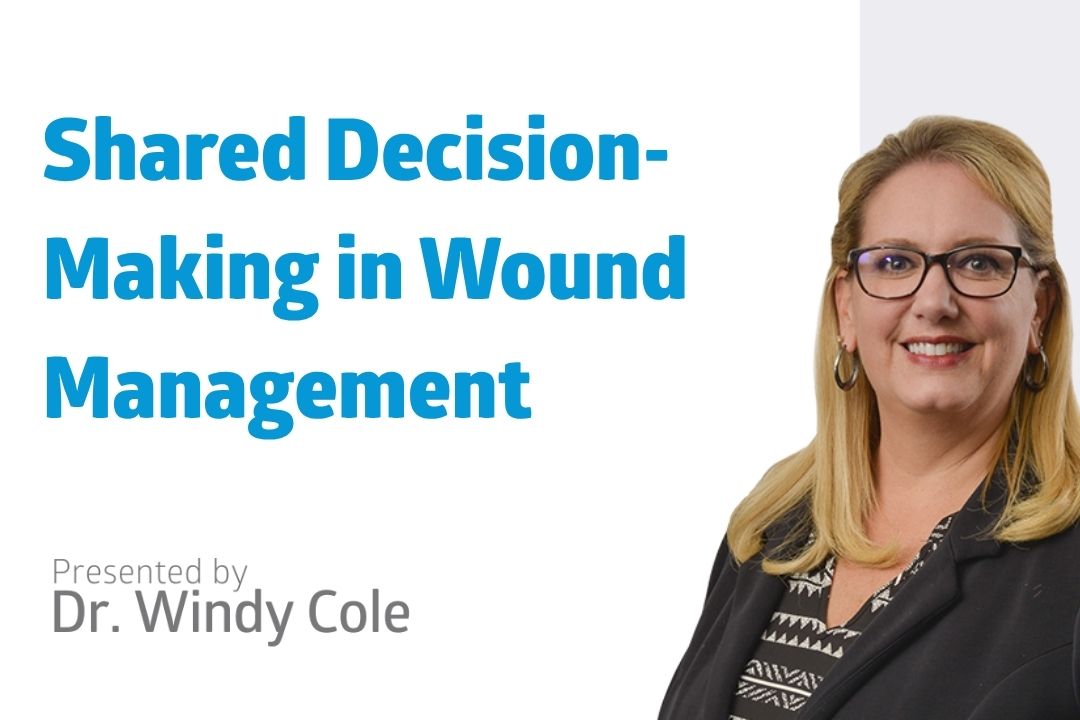Shared Decision-Making in Wound Management

Empowering Patients Through Shared Decision-Making in Wound Management
Presented by Dr. Windy Cole, DPM, CWSP
In today’s rapidly evolving healthcare landscape, one principle remains steadfast: patients deserve to be heard, respected, and involved in decisions about their own care. In wound management, where treatment paths can be complex and deeply personal, Shared Decision-Making (SDM) serves as a powerful framework for aligning clinical expertise with individual patient values.
What Is Shared Decision-Making?
Shared Decision-Making is more than a clinical tool—it’s a transformational process that redefines the relationship between patient and provider. Instead of decisions being dictated solely by the clinician, SDM invites patients into the conversation, allowing their goals, preferences, and lifestyle to guide the treatment plan.
When patients and providers work as partners, the outcome isn’t just a treatment—it’s a commitment to care that patients understand, believe in, and are more likely to follow through with.
The SHARE Approach to SDM
To support meaningful dialogue in wound care consultations, I often rely on the SHARE mnemonic—a simple yet effective guide to navigating SDM:
S – Seek the patient’s participation
H – Help the patient explore & compare treatments
A – Assess the patient’s values and preferences
R – Reach a decision together
E – Evaluate the patient’s decision
Using SHARE ensures that every discussion is both comprehensive and compassionate. It’s not about overwhelming patients with information—it’s about helping them make informed, confident choices.

Why SDM Matters in Wound Management
Chronic wounds are not only physically burdensome but can also take a significant emotional toll. That’s why SDM in wound care goes beyond clinical efficacy—it addresses quality of life, psychosocial needs, and daily functionality.
As a clinician, I’ve seen firsthand how patients feel more empowered and satisfied when they have a voice in their treatment. Whether it’s choosing a dressing that fits their mobility or selecting an advanced therapy, involvement breeds trust, adherence, and better outcomes.
How NATROX® O₂ Supports Shared Decision-Making
One adjunctive therapy that aligns well with SDM principles is NATROX® O₂, a topical oxygen therapy designed for wound healing. Here’s why it enhances the SDM experience:
- Compatible with many treatment plans: NATROX® O₂ integrates easily into advanced wound care protocols, offering flexibility in care strategies.
- Lifestyle-friendly design: The discreet, portable nature of the device supports activities of daily living, reducing disruption and promoting patient satisfaction.
- Evidence-backed performance: With robust clinical evidence supporting its use, patients can make informed choices with confidence.
By incorporating NATROX® O₂ into the conversation, clinicians can offer a versatile, patient-centered option that respects individual lifestyles while still delivering advanced care.
Building a Culture of Patient-Centered Care
At the heart of SDM is a simple yet profound idea: the best care decisions happen when patients and clinicians collaborate. Here’s how we make that happen:
- Open communication: We take the time to explain all treatment options, along with potential risks and benefits.
- Evidence-based insights: Our recommendations are grounded in the latest clinical research.
- Patient autonomy: Ultimately, we respect the patient’s right to make choices that align with their life and values.
As providers, we don’t just treat wounds—we care for people. And when people feel empowered, respected, and involved, healing becomes more than a clinical goal—it becomes a shared success.
Dr. Windy Cole, DPM, CWSP is a passionate advocate for advancing wound care through evidence-based innovation and patient-centered care. She champions Shared Decision-Making as a cornerstone of clinical excellence.
Click below to watch Dr. Cole speaking about shared decision-making at EWMA 2025.
Keywords: Wound healing, Continuous Topical Oxygen Therapy, NATROX O₂, Chronic wounds, EWMA 2025, Wound care, Medical innovation, Healthcare technology, Clinical data, Patient care, Health tech, Medical devices, Clinical research, Innovation spotlight, Wound management, Share Decision Making